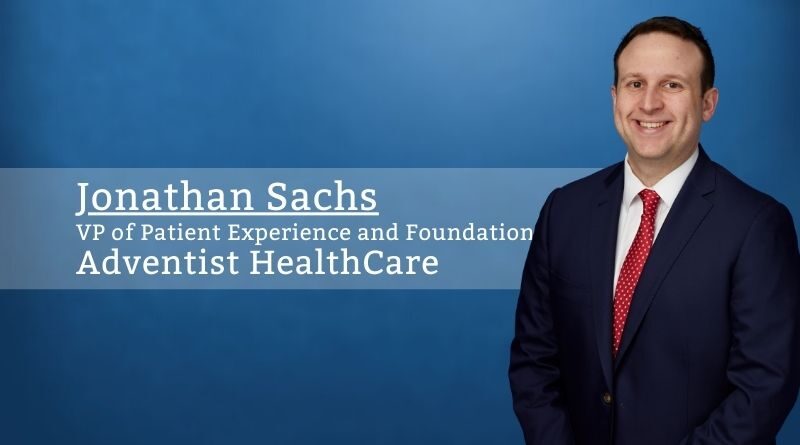Finding the Right Tech for Improving Patient Experience
By Jonathan Sachs, MBA, FACHE, VP of Patient Experience and Foundation, Adventist HealthCare
In 2019, I had just boarded a flight back from a vacation with my wife when we received one of those dreaded phone calls that so many of us worry about. My older sister had suffered a severe seizure and, while stable, would be having surgery in the coming days. When we landed, my wife and I visited my sister in the hospital, the first of several hospitals where we would visit her over the coming months.
In one of her rooms, I noticed an iPad hanging on the wall in a mounted holder, collecting dust. When I asked the nurse what it was for, I was told that it was for patients to use to access their records, but few were taking advantage of it. During my sister’s hospital stay, she neither picked it up, nor did any of her visitors.
When we think about integrating technology to improve the patient experience, it is essential to realize that while the opportunities are endless, it does not mean all should be pursued. Generally speaking, patient experience is notoriously difficult to improve because it is dependent on an organization’s culture. Technology can be an important catalyst for change, a critical component to ensuring a consistent patient journey, and a vital means to access care. At the same time, not all technology should necessarily be implemented. Tech still cannot substitute for essential human-to-human connections that are unique to the missions of healthcare organizations.
Thus far in Adventist HealthCare’s patient experience journey, we are using tools to better understand our patients, including psychographic factors like emotions, throughout their patient journeys. To accomplish this goal, we are utilizing AI, natural language processing, and big data.
Early on, we identified that we were over-reliant on the data from the CMS mandated HCAHPS survey. The HCAHPS survey is long, specific, and can only collect data either by phone or by traditional mail. While the HCAPHS data offers valuable insights, we knew we needed to expand our listening methods to learn more about patient preferences and what aspects of care are most important to their overall care rating.
As a supplement to the HCAHPS survey, we are the first healthcare company in the US to engage with a company called Worthix. Worthix utilizes AI and natural language processing to explore a patient’s open-text feedback and analyze the data in aggregate. We are currently sending Worthix “dialogues” to patients who receive inpatient care but are not selected in the sample to obtain the HCAHPS survey.
As we expanded beyond the HCAHPS survey, we realized we had several different data components that were not connected. We felt like we needed to find a way to collect and then analyze all our patient listening methods. We discovered that we had nearly ten sources of data where we get direct regular patient feedback, including the HCAHPS survey, Worthix dialogues, online reviews, and others. We are using a Press Ganey product called NarrativeDX, where we have connected direct feeds of unedited patient comments from these sources. NarrativeDX analyzes all the patient comments and groups them into insights that match the HCAHPS survey, which we use as outcome measures.
Once the data is collected and analyzed, visualization makes it simple and actionable. To add more impact, both NarrativeDX and Worthix allow us to share data down to the individual unit level to make it actionable for clinicians. We have also used data visualization and automation to create a scorecard and a dashboard, breaking data down to each individual’s clinical unit, department, or location.
This data enables us to solve existing problems and be intentional about designing the patient journey in any unit or specialty based on the preferences of previous and potential patients. The data allows teams to anticipate patient needs better and to plan for the future.
The challenges to implementing our data strategy have centered on survey fatigue from patients leading to low response rates. We have shortened our surveys where possible, made them accessible by text message, and arranged our system so that no patient receives more than one survey type from us. Additionally, pulling fragmented systems together for collecting patient feedback together has been challenging. This problem is a hallmark of healthcare systems and one that is ripe for an artificial intelligence solution.
Our next step in our patient experience technology journey is to find solutions that make accessing, receiving, and paying for care simpler and more reliable for our patients. From there, many of the opportunities we have identified are in care post-discharge.
One of the boundaries that we have set in using technology to improve patient experience is preserving the parts of the journey that require human compassion. There are also some areas where automation is possible but would detract from the human-to-human parts of the patient experience. For example, the technology to automate patient transport using autopilot technology from cars is here. But the transitions in care involving transportation can be especially stressful for a patient. Transporting patients to surgery or a test is often where conversations occur, during which patients discuss their emotions and are reassured or calmed down. I also do not foresee technology being used to deliver news like a cancer diagnosis. Implementing technology must be respectful of these important moments where our system lives out on our mission to, “Extend God’s care through the ministry of physical, mental, and spiritual healing.”
Technologies like AI with real-time response, natural language processing, and big data can help us know and remember our patients in ways that wouldn’t be possible without these tools, helping to customize a patient’s care. As more healthcare systems focus on patient experience, the temptation is to over-tech for standardization and consistency. Still, the future successful hospitals will know how to blend groundbreaking new tools with the human connection required in delivering compassionate, empathetic care.
When we analyze our comments, the most detailed and impactful we find are about how our team members treat our patients. Technology can be used to create intimacy with the patient so long as it is deployed next to a people-driven system for delivering consistently empathic and compassionate care.



